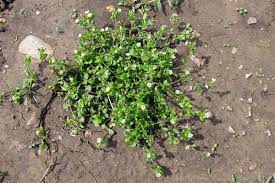CHICKWEED
- Dave

- Mar 30, 2023
- 4 min read
Updated: Apr 8
Chickweed

Botanical Name
Stellaria media, S. holostea, Stellaria spp.
Common Name
Chickweed, stitchwort, star weed, starwort, tongue grass, adder’s mouth
Family
Caryophyllaceae
Parts Used
Aerial parts; root used in Chinese medicine
Native To
Europe and Asia
Harvesting Guidelines
Chickweed is an abundant and resilient herb, often found growing wild in gardens and shaded areas. It is best harvested during its peak growth in the spring and fall when its leaves and flowers are fresh and tender. For medicinal use, the aerial parts—leaves, stems, and flowers—are harvested. Chickweed can be easily grown in gardens, where it self-seeds and is hardy enough to withstand colder weather. When harvesting in the wild, make sure to leave part of the plant to ensure it can regenerate and continue to grow.
Chickweed is a low-growing, fast-spreading herb found in a wide variety of environments. It flourishes in nutrient-rich, moist soil and is commonly seen growing in gardens, lawns, and forested areas, especially during the cooler months of spring and fall. Known for its small, star-like white flowers, chickweed has long been regarded as both a nutritious food and a powerful medicinal herb. Traditionally, it has been used by many cultures, including Native Americans and European herbalists, for its cooling, soothing, and cleansing properties.
Historically, chickweed was especially popular in the "Victory Gardens" of the World War II era, where its high nutritional value and ease of cultivation made it a favorite for home gardeners. Native American tribes, including the Iroquois, used chickweed both as a food and as a poultice for conditions such as skin rashes, wounds, and inflammation. Its reputation as a remedy for internal and external inflammation has stood the test of time, making it a staple in many herbal traditions. In spiritual practice, chickweed is often considered a symbol of healing, renewal, and nourishment, and its cooling energy is said to balance excessive fire or heat within the body.
Chickweed’s spiritual properties are deeply linked to its growth cycle and ability to rejuvenate. It is one of the first greens to emerge in early spring, signaling new life and regeneration, and it often reappears in the fall, reinforcing the idea of restoration. In this way, chickweed symbolizes vitality, resilience, and the cyclic nature of healing.
In terms of its medicinal uses, chickweed is highly regarded for its ability to nourish and tonify the body, especially after the harsh conditions of winter. Packed with vitamins, minerals, and essential fatty acids, it is known to support a healthy metabolism and is often used to enhance overall vitality. The plant is especially useful for cleansing the lymphatic system, eliminating excess water, and supporting kidney and liver function.
Modern scientific studies have validated many of chickweed's traditional uses. Chickweed is rich in saponins, which are believed to help break down excess fat and mucus in the body. These compounds, along with its diuretic properties, support the body in detoxifying and eliminating waste. Chickweed has also been studied for its ability to support the liver, kidneys, and lymphatic system, helping to maintain a healthy balance of fluids in the body.
Chickweed is especially valued for its demulcent and emollient properties, which make it an excellent choice for soothing and moisturizing dry, irritated skin. It is also used to ease discomfort from conditions like eczema and psoriasis, with many modern herbalists recommending chickweed salves and oils for chronic skin issues.
Adult Dose (4) (5)
Food: 1-3 cups a day fresh, cooked, or pickled.
Infusion: 6-12 fl oz (made with 1 oz dried herb in 1 quart water) up to 3x/day
Tea: 8 fl oz (1 tsp dried herb in 1 cup water) 3x/day (
Tincture: 2-5 mL fresh herb (1:2, 95%) or dried herb (1:5, 50%)
Salve or oil: Topical use as needed daily and persistently for skin problems; effects may take up to 6 months
Succus: 3-6 mL daily
Decoction: 3-9 g/day yin chai hu (Stellaria dichotoma) root
Safety
Chickweed is generally safe for consumption, though individuals with known allergies to plants in the Caryophyllaceae family should exercise caution. Rare reports of contact dermatitis have been noted, especially after handling the plant. Pregnant and breastfeeding women can safely consume chickweed in food quantities, but large amounts of seeds should be avoided, as they may cause digestive issues such as diarrhea. As always, moderation is key.
Actions
Alterative,Antiinflammatory,Antibacterial,Antiviral,Demulcent,Emollient,Lymphatic,Nutritive,Vulnerary
Energy
Cooling,Moistening
References:
Blair, K. (2015). The Wild Wisdom of Weeds: 13 Essential Plants for Human Survival. North Atlantic Books.
Matu, E. N., et al. (2010). Antimicrobial, Anti-inflammatory, and Antioxidant Activities of Stellaria media. Pharmaceutical Biology, 48(7), 691–698. https://doi.org/10.3109/13880209.2010.505026
Moerman, D. E. (1998). Native American Ethnobotany. Timber Press.
Information offered on Achula and on this page is for educational purposes only. Achula makes neither medical claim, nor intends to diagnose or treat medical conditions. Women who are pregnant or nursing, and persons with known medical conditions, should consult their licensed healthcare provider before taking any herbal product. Links to external sites are for informational purposes only. Achula neither endorses them nor is in any way responsible for their content. Readers must do their own research concerning the safety and usage of any herbs or supplements.
tags:
Herbal medicine course
herbal school
wildpluk cursus
kruiden opleiding
geneeskrachtige planten
herborist
become a herbalist







